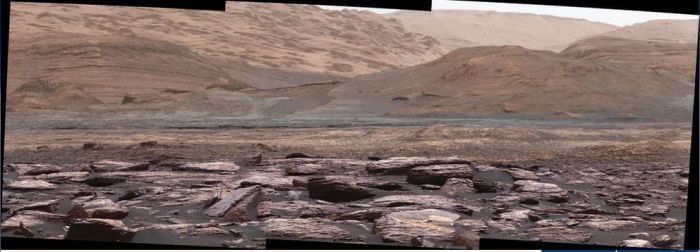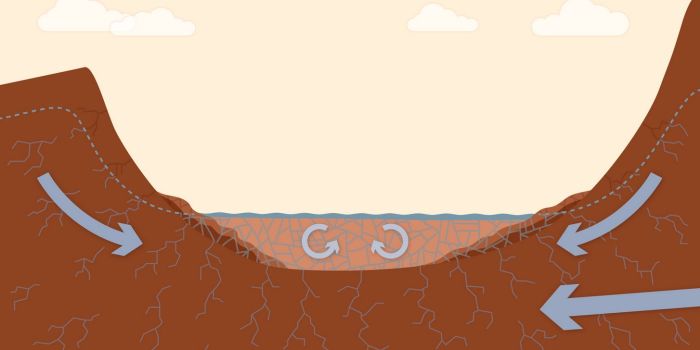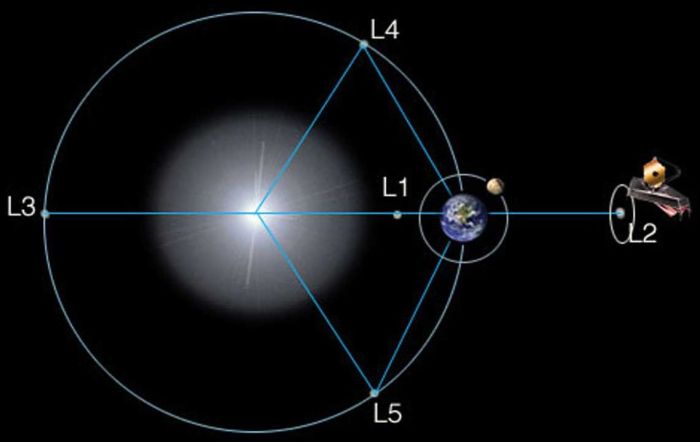
For more than a year now, NASA’s Mars Science Laboratory rover, Curiosity, has been slowly climbing the lower slopes of “Mount Sharp” – more formally called Aeolis Mons, the 5 kilometre (3 mi) high layered deposit extending off of the central peak of Gale Crater. Whilst still on the lower slopes of the mound, the rover has already found minerals absent from lower levels within the crater, and these, together with the ample evidence for water once having existed in the crater, further point to Mars perhaps having once been habitable.
Details of the latest findings from Curiosity were presented at a meeting of the American Geophysical Union (AGU), which commenced on Monday, December 12th, in San Francisco. Making the presentation were members of the current MSL science team and its former principal investigator, John Grotzinger, – the Fletcher Jones Professor of Geology at Caltech.
Mineral veins are an important way to study the movements of water within a location, as they are result of cracks in layered rock being filled with chemicals that are dissolved in water. This alters the chemistry and composition of rock formations, providing vital clues on the prevailing conditions around the time they were deposited.

In the case of the slopes most recently examined by Curiosity, the science team have found that hematite, clay minerals and boron are more abundant than has been found in the lower, older layers. These point to a complex environment where groundwater interactions led to clay-bearing sediments and diverse minerals being deposited over time, effectively creating a “chemical reactor” which, although no actual evidence for Martian microbes having existed within the minerals has been found, still creates an environment which may have been beneficial life.
“There is so much variability in the composition at different elevations, we’ve hit a jackpot,” Grotzinger said during the presentation. “A sedimentary basin such as this is a chemical reactor. Elements get rearranged. New minerals form and old ones dissolve. Electrons get redistributed. On Earth, these reactions support life.”

The increasing presence of hematite found by the rover as it continues up “Mount Sharp” suggests both warmer conditions and more interaction with the atmosphere at higher levels. In addition, the increasing concentrations of hematite, relative to magnetite at lower levels further suggests that iron oxidisation increased over time, creating the “chemical reactor” Grotzinger referenced: the loss of electrons through the oxidisation process can provide the energy necessary for life to sustain itself.
Another ingredient increasing in recent measurements by Curiosity is the element boron, which the rover’s laser-shooting Chemistry and Camera (ChemCam) instrument has been detecting within calcium sulphate mineral veins. Boron is famously associated with arid sites where much water has evaporated away. However, the amounts found so far are so minor, they make it much harder to determine the environmental implications of their presence.
Currently the team is considering at least two possibilities. In the first, the evaporation of the lake thought to have once existed within Gale Crater formed a boron-containing deposit in an overlying layer, not yet reached by Curiosity, then water later re-dissolved the boron and carried it down through a fracture network into the layers the rover is currently investigating, where it accumulated along with fracture-filling vein minerals. In the second, changes in the chemistry of clay-bearing deposits, such as evidenced by the increased hematite, affected how groundwater picked up and dropped off boron within the local sediments.

Either way, the deposits point to the region once being a dynamic environment, with the minerals interacting with groundwater, which then influenced the chemical composition of the surrounding clays, which in turn changed the composition of the water, which then further influenced its surroundings, and the minerals it contained.
“We are seeing chemical complexity indicating a long, interactive history with the water,” Grotzinger said.”The more complicated the chemistry is, the better it is for habitability. The boron, hematite and clay minerals underline the mobility of elements and electrons, and that is good for life.”
The MSL mission was recently granted a further 2-year extension through to September 2018, during which it will study the “Hematite Unit” and the “Clay Unit” shown in the aerial view, above.
NASA / SpaceX Delay First Crewed Dragon Flight
NASA and SpaceX have confirmed that the first planned flight of a crewed SpaceX Dragon V2 capsule has been put back from 2017 to 2018.
Dragon V2, along with the Boeing CT-100 Starliner capsule, is due to provide the means to lift crews to the International Space Station (ISS) from US soil, and return them again. It is being developed as a part of NASA’s Commercial Crew Programme (CCP), which is intended to leave the US space agency free of the burden of taxi flights to / from the ISS so it can focus on more ambitious crewed spaceflight goals.

The delay in the first Dragon V2 demonstration flight is not entirely unexpected. In September 2016, a SpaceX Falcon 9 booster – the same vehicle as will be used to launch the Dragon V2 – suffered a catastrophic launchpad failure during a pre-flight test, resulting in the complete loss of the launcher and its Amos-6 Israeli satellite payload. Since then, all Falcon flights have been put on hold, and while SpaceX are confident they have found the cause for the September 1st loss, Falcon will not now re-enter service until at least January 2017, pending Federal Aviation authority approval. As a result, the entire launch manifest for the rocket is subject to delay.
The September 1st loss also raised safety concerns for crews aboard the Dragon V2. To minimise risk, it has been a standing policy with US space missions that the crew only board a launch vehicle after it is fully fuelled and awaiting lift-off. However, to reduce the complexity of the vehicle, and reduce the volume of fuel tank space required for its super-cold propellants, the Falcon 9 requires fuelling to be the last stage of the pre-launch preparations, with the crew already on-board.

The process had previously been approved by NASA’s Safety Technical Review Board in July 2016, on the grounds that SpaceX has demonstrated that should anything go wrong with the fuelling process, the Dragon V2 launch abort system should be able to lift the capsule and crew to safety and a parachute landing. However, since the September 1st loss, the International Space Station Advisory Committee has raised written concerns about the SpaceX approach, and it is not clear if the concerns have been fully addressed.
Boeing’s CT-100 Starliner is also now behind its anticipated test flight schedule, with the first crewed flight of that vehicle not anticipated before August 2018.
Jupiter’s “String of Pearls”

On Sunday, December 11th, The Juno spacecraft swept around Jupiter for the third time, passing some 4,150 km (2,580 mi) over the upper reaches of the giant planet’s swirling clouds at a speed of around 206,400 km/h (129,000 mph), or 57.8 km (36.1 mi) per second, relative to the planet. During the period immediately before and following this point of closest approach – perijove – the JunoCam was busy capturing images of the largest planet in the solar system, and in doing so caught some stunning images of one of Jupiter’s visual phenomena.
Jupiter’s Great Read Spot, a centuries old storm, three Earth diameters across, is perhaps the most famous storm in the solar system. However, it is far from the only storm raging in the planet’s dense atmosphere. Further south lay a chain of off-white storms which vary from six to nine in number since detailed observations of them began in 1986. They are known collectively as the “string of pearls” – and it was two of these Juno imaged during its high-speed pole-to-pole pass around the planet.
Jupiter’s atmosphere comprises a series of “belts” or dark material and “zones” of lighter material forming the familiar stripped banding around the planet. They are separated by powerful jet streams which alternate direction from one band to the next. The lighter “zones” are thought to be material welling up on currently from deeper within the planet, with ammonia ice giving them their lighter colour. The darker “belts” are thought of be rich in hydrocarbons (molecules that are made from hydrogen, carbon, and oxygen) and exotic sulphur and phosphorus compounds, which are sinking back down into the planet’s atmosphere.

The “strong of pearls” occurs in the SS Temperate belt, the lowest major banding in the Jovian atmosphere prior to the south polar regions. They vary in number as some of them are drawn together by the winds / planet’s rotation, only to later break apart again. Their light colour may be indicative of concentrations of ammonia ice. In the images captured by Juno on December 11th, the largest of the storms (seen on the right of the image directly below the title to this section) is roughly the diameter of the Earth in size.
Following the flyby, mission staff gave more information on the software update intended for the Jovian Infra-red Auroral Mapper (JIRAM) instrument aboard Juno, which was shut down during the passage around Jupiter. It now appears that how JIRAM interacts with Juno’s computer was responsible for tripping the spacecraft into a safe mode 13 hours before its flyby on Jupiter in October, and the instrument was shut down in order to avoid a repeat occurrence. The software patch, which has yet to be installed on Juno’s computer system, is designed to prevent the problem occurring again.
Investigations are still continuing into the valve issue affecting Juno’s main engine and which is preventing it from manoeuvring into a more circular 14-day orbit around Jupiter. However, the science team for the mission have again indicated that even if Juno cannot complete the burn during a future close pass around the planet, it can still complete its primary mission from its current 53.5 day orbit.
James Webb Deployment and Operation
NASA’s James Webb Space Telescope (JWST) has been noted a number of times in my Space Sunday pieces during 2016, and I’ve received a number of request for more information about the mission and its orbit.
The best place to keep up-to-date with the project is via the JWST’s own website, however, I thought I’d offer a brief recap on the mission, together with a NASA video about it.

Due for launch in October 2018 atop a European Ariane V booster, JWST is essentially the successor to the Hubble Space Telescope (HST). but with a primary mirror over 2.5 times the diameter of Hubble’s, the JWST will be 100 times more powerful than its predecessor, and will be capable of looking over 13 billion years in time. It is designed to occupy the Sun / Earth L2 position, one of the points at with the gravities of Earth and the Sun effectively “cancel” one another out, producing a region of relative gravitational “calm”. This lies approximately 1.5 million km (930,000 mi) beyond the Earth, relative to the Sun.
To reach that point, well beyond the reach of maintenance support from Earth, the JWST must go through a complex launch, orientation, coast and deployment and commissioning flight lasting a total of around 160 days from launch through to the commencement of operations. Just how complex that flight will be, and just how intricate a piece of equipment JWST is, can be seen in the video below, first issued by NASA in June 2016.